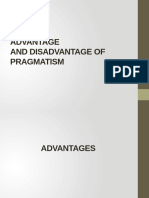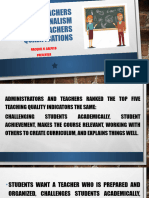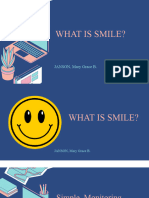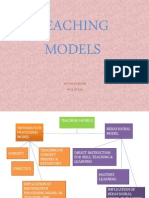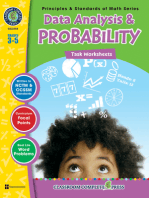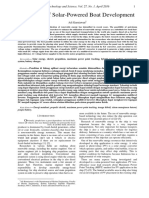0 ratings0% found this document useful (0 votes)
34 viewsAdaptive Learning
Adaptive Learning
Uploaded by
Maryam AfzalAdaptive learning is an educational method that uses computers and data to personalize the learning experience for each student. It assesses students' mastery of concepts in real-time and dynamically adjusts subsequent lessons and activities. This approach aims to improve learning by addressing individual needs and allowing students to learn at their own pace. Adaptive learning arrived in the 1950s through the work of behaviorist B.F. Skinner and focuses on effectively teaching new concepts rather than memorization. Benefits include better student progress and engagement through personalized feedback and collaboration between students and teachers.
Copyright:
© All Rights Reserved
Available Formats
Download as PPTX, PDF, TXT or read online from Scribd
Adaptive Learning
Adaptive Learning
Uploaded by
Maryam Afzal0 ratings0% found this document useful (0 votes)
34 views13 pagesAdaptive learning is an educational method that uses computers and data to personalize the learning experience for each student. It assesses students' mastery of concepts in real-time and dynamically adjusts subsequent lessons and activities. This approach aims to improve learning by addressing individual needs and allowing students to learn at their own pace. Adaptive learning arrived in the 1950s through the work of behaviorist B.F. Skinner and focuses on effectively teaching new concepts rather than memorization. Benefits include better student progress and engagement through personalized feedback and collaboration between students and teachers.
Copyright
© © All Rights Reserved
Available Formats
PPTX, PDF, TXT or read online from Scribd
Share this document
Did you find this document useful?
Is this content inappropriate?
Adaptive learning is an educational method that uses computers and data to personalize the learning experience for each student. It assesses students' mastery of concepts in real-time and dynamically adjusts subsequent lessons and activities. This approach aims to improve learning by addressing individual needs and allowing students to learn at their own pace. Adaptive learning arrived in the 1950s through the work of behaviorist B.F. Skinner and focuses on effectively teaching new concepts rather than memorization. Benefits include better student progress and engagement through personalized feedback and collaboration between students and teachers.
Copyright:
© All Rights Reserved
Available Formats
Download as PPTX, PDF, TXT or read online from Scribd
Download as pptx, pdf, or txt
0 ratings0% found this document useful (0 votes)
34 views13 pagesAdaptive Learning
Adaptive Learning
Uploaded by
Maryam AfzalAdaptive learning is an educational method that uses computers and data to personalize the learning experience for each student. It assesses students' mastery of concepts in real-time and dynamically adjusts subsequent lessons and activities. This approach aims to improve learning by addressing individual needs and allowing students to learn at their own pace. Adaptive learning arrived in the 1950s through the work of behaviorist B.F. Skinner and focuses on effectively teaching new concepts rather than memorization. Benefits include better student progress and engagement through personalized feedback and collaboration between students and teachers.
Copyright:
© All Rights Reserved
Available Formats
Download as PPTX, PDF, TXT or read online from Scribd
Download as pptx, pdf, or txt
You are on page 1of 13
ADAPTIVE LEARNING
DEFINITION OF ADAPTIVE LEARNING
• A METHOD OF EDUCATION THAT USES COMPUTERS AND DATA TO ADJUST THE
LEARNING EXPERIENCE TO THE INDIVIDUAL STUDENT. WE FOCUS ON ADAPTIVE
LEARNING TO ENABLE THE STUDENTS TO LEARN AT THEIR OWN PACE MAKING
LEARNING MORE EFFECTIVE AND INTERESTING.
EXAMPLE OF ADAPTIVE LEARNING
• FOR EXAMPLE, IF A STUDENT STRUGGLES WITH ADDING FRACTIONS, A TEACHER
MIGHT OFFER 1:1 TUTORING OR ADDITIONAL PRACTICE PROBLEMS.
WHAT IS ADAPTIVE LEARNING
• ADAPTIVE LEARNING, ALSO KNOWN AS ADAPTIVE TEACHING, IS AN
EDUCATIONAL METHOD WHICH USES COMPUTER ALGORITHMS AS WELL AS
ARTIFICIAL INTELLIGENCE TO ORCHESTRATE THE INTERACTION WITH THE
LEARNER AND DELIVER CUSTOMIZED RESOURCES AND LEARNING ACTIVITIES
TO ADDRESS THE UNIQUE NEEDS OF EACH LEARNER.
HOW DOES ADAPTIVE LEARNING WORK ?
• AT THE MOST BASIC LEVEL, ADAPTIVE LEARNING SOFTWARE ASSESSES A
STUDENT’S MASTERY OF A CONCEPT OR SKILL IN REAL TIME AND THEN
DYNAMICALLY ADJUSTS THE NEXT LESSON OR PRACTICE ACTIVITY PRESENTED
TO THAT STUDENT, RESULTING IN IMPROVED LEARNING.
HISTORY OF ADAPTIVE LEARNING
ADAPTIVE LEARNING ARRIVED ON THE EDUCATIONAL SCENE IN THE 1950S.
BEHAVIORIST, B.F. SKINNER, IS CREDITED WITH CREATING THE METHOD. SKINNER
CONSTRUCTED A TEACHING MACHINE THAT FOCUSED ON EFFECTIVELY TEACHING
NEW CONCEPTS INSTEAD OF REINFORCING MEMORIZATION.
IMPORTANCE OF ADAPTIVE TEACHING
• WHY IS ADAPTIVE TEACHING IMPORTANT? ADAPTIVE TEACHING IS VITAL IN
ENSURING THAT ALL LEARNERS ACHIEVE THE BEST POSSIBLE OUTCOMES.
ADAPTIVE TEACHING: HELPS TO CULTIVATE A MORE INCLUSIVE CLASSROOM
SPACE, WHERE EACH CHILD’S NEEDS HAVE BEEN ADDRESSED.
BENEFITS OF ADAPTIVE LEARNING IN THE
CLASSROOM
•STUDENTS GET REAL-TIME FEEDBACK.
•TEACHERS GET INSIGHTS INTO STUDENT NEEDS VIA DATA.
•DECREASED RISK OF STUDENTS FALLING BEHIND AND GIVING UP.
•FACULTY AND STUDENT INTERACTIONS ARE MORE PRODUCTIVE.
•THE TECHNOLOGY ACTIVELY PUTS INTO PRACTICE RESEARCH ON HOW PEOPLE
LEARN.
ADVANTAGES OF ADAPTIVE LEARNING
KEY BENEFITS OF ADAPTIVE LEARNING:
BETTER & FASTER PROGRESS.
IMPROVED LEARNING.
ENHANCED UNDERSTANDING.
BETTER STUDENT ENGAGEMENT.
SYSTEMATIC STUDENT-TEACHER COLLABORATION.
STUDENTS FEEL MORE MOTIVATED.
IDENTIFY GAPS AND GET REAL-TIME FEEDBACK.
• IMPROVES ENGAGEMENT AND SUPPORTS LEARNING FOR DIVERSE GROUPS.
DISADVANTAGES OF ADAPTIVE LEARNING
OTHER WEAKNESSES OF ADDITIVITY
• LEARNERS COULD FEEL LONELY IN AN ONLINE-ONLY AND ADAPTIVE-ONLY
PLATFORM. THE PATHS THE LEARNER TAKES COULD LEAD TO OVERJUMPING
IMPORTANT LEARNING CONTENT AND RELATIONS TO PROBLEM-SOLVING AND
INDIVIDUAL NEEDS—THEY GO LEFT AND MISS OUT ON THE RIGHT.
CHALLENGE’S OF ADAPTIVE LEARNING
MOVING AHEAD WITHOUT EVIDENCE.
FINDING RESOURCES FOR DEVELOPMENT.
WINNING OVER INSTRUCTORS AND STUDENTS.
SELECTING THE RIGHT TEAM OR PROVIDER.
• DEALING WITH EXTENSIVE DATA.
ADAPTIVE LEARNING TOOLS
•ADAPTIVE LEARNING SOFTWARE PERSONALIZES LEARNING BY USING ARTIFICIAL
INTELLIGENCE AND MACHINE LEARNING TECHNIQUES TO “ADAPT” THE LEARNING
PATH OFFERED TO AN INDIVIDUAL STUDENT IN REAL TIME.
THANK YOU
DO YOU HAVE ANY QUESTIONS?
• PRESENTED BY
• HAFIZ MUHAMMAD ZESHAN
• MUHAMMAD ARSLAN
•B’S ENGLISH LINGUISTICS MORNING. B
•THE ISLAMIA UNIVERSITY OF BAHAWALPUR
You might also like
- Env Pre by RanaDocument19 pagesEnv Pre by RanaPervez RanaNo ratings yet
- Unit 4 8623Document23 pagesUnit 4 8623Eeman AhmedNo ratings yet
- Role of Educational Resource Centre in Teaching MathematicsDocument17 pagesRole of Educational Resource Centre in Teaching MathematicsVrinthaNo ratings yet
- Role of Educational Resource Centre in Teaching MathematicsDocument17 pagesRole of Educational Resource Centre in Teaching MathematicsAbisha AbiNo ratings yet
- Integrative Learning in The 21st Century EducationDocument31 pagesIntegrative Learning in The 21st Century Education56Niccos100% (2)
- Benefits of Remote Learning During This Time of PandemicDocument10 pagesBenefits of Remote Learning During This Time of PandemicClarisse SampangNo ratings yet
- Adaptive Learning: Maria Clariza J. OquiasDocument26 pagesAdaptive Learning: Maria Clariza J. OquiasSha RonNo ratings yet
- Instructional CycleDocument42 pagesInstructional CycleShayne Klarisse DinamlingNo ratings yet
- Ubiquitous LearningDocument60 pagesUbiquitous LearningMa Ellaine GamboaNo ratings yet
- Ubiquitous LearningDocument60 pagesUbiquitous LearningMa Ellaine GamboaNo ratings yet
- New Approaches in Education-Kristine AlcantaraDocument23 pagesNew Approaches in Education-Kristine AlcantaraRudelyn AlcantaraNo ratings yet
- Distance EducationDocument58 pagesDistance Educationlumina.sNo ratings yet
- Learning Centers Within A Classroom Gulnaz Aslanova 2Document13 pagesLearning Centers Within A Classroom Gulnaz Aslanova 2api-349700673No ratings yet
- Technology in Explaining A Lesson HernandezDocument8 pagesTechnology in Explaining A Lesson HernandezKim ArdaisNo ratings yet
- Schools of The FuturepppDocument9 pagesSchools of The Futurepppahmed.khan.ccNo ratings yet
- Teachingstrategies 170115134302Document25 pagesTeachingstrategies 170115134302ASHISH KUMAR YADAVNo ratings yet
- Adaptive Learning TechDocument6 pagesAdaptive Learning Techapi-322071419No ratings yet
- Flexible Learning Experiences EnhancingDocument18 pagesFlexible Learning Experiences EnhancingKeyrenNo ratings yet
- Pragmatism Report G5Document15 pagesPragmatism Report G5rosielynanubmagtrayoNo ratings yet
- MoLS - Innovative Pedagogy - August 2024Document116 pagesMoLS - Innovative Pedagogy - August 2024Agegnehu dogisoNo ratings yet
- Prof Ed NotesDocument21 pagesProf Ed NotesEva Joy DelacruzNo ratings yet
- 2 C 2 I 1 RDocument31 pages2 C 2 I 1 RIreneRoseMotasNo ratings yet
- Individualized InstructionDocument19 pagesIndividualized InstructionAurelio Borbon Montejo Jr.100% (1)
- Pedagogical ApproachesDocument31 pagesPedagogical ApproachesRomeo IdusmaNo ratings yet
- Different Approaches and Methods FalDocument38 pagesDifferent Approaches and Methods Faljami hingNo ratings yet
- Quality Teachers Racquel CalpitoDocument36 pagesQuality Teachers Racquel Calpitojhoana.colladoNo ratings yet
- English texts 2025 lect.1Document15 pagesEnglish texts 2025 lect.1Osama OpticsNo ratings yet
- Evolving Themes & Special ConcernDocument26 pagesEvolving Themes & Special ConcernMicah M Amaro100% (4)
- Preeti Jaiswal M.Sc. (N) 1 YRDocument38 pagesPreeti Jaiswal M.Sc. (N) 1 YRSeema YadavNo ratings yet
- Literature ReviewDocument10 pagesLiterature ReviewAlicia Taborsky JonesNo ratings yet
- Report in Technology For Teaching and LearningDocument2 pagesReport in Technology For Teaching and LearningJustine Jann ReyesNo ratings yet
- Diffusion Tech Int Project Cooper Lemonds Parker TrimmerDocument33 pagesDiffusion Tech Int Project Cooper Lemonds Parker Trimmerapi-518087342No ratings yet
- Instructions in The Early Generations vs. Instructions in The 21st CenturyDocument15 pagesInstructions in The Early Generations vs. Instructions in The 21st Centuryshaira alliah de castro100% (1)
- Principles of Teaching 1Document204 pagesPrinciples of Teaching 1taekooktoook mybreathawayNo ratings yet
- EdtechDocument8 pagesEdtechNico John Bauzon CapuaNo ratings yet
- Technology in Education FinalDocument11 pagesTechnology in Education FinalSaiful IslamNo ratings yet
- Contextualization and Location NTOT AP G10 1Document30 pagesContextualization and Location NTOT AP G10 1Clent AstibeNo ratings yet
- Miss. Ramanpreet Kaur Lecturer College of Nursing Shaheed Kartar Singh SarabhaDocument37 pagesMiss. Ramanpreet Kaur Lecturer College of Nursing Shaheed Kartar Singh SarabhaSimran JosanNo ratings yet
- L3 - M3117 - Enhancement of Mathematics Learning PlanDocument50 pagesL3 - M3117 - Enhancement of Mathematics Learning PlanFernan GonzalesNo ratings yet
- Affecting the CurriculumDocument20 pagesAffecting the CurriculumEllen MarapocNo ratings yet
- Simple, Monitoring, Interactive, Learner-Centric Environment (SMILE)Document13 pagesSimple, Monitoring, Interactive, Learner-Centric Environment (SMILE)Grace JansonNo ratings yet
- Different Approaches and Methods: "A Thousand Teachers, A Thousandmethods."Document49 pagesDifferent Approaches and Methods: "A Thousand Teachers, A Thousandmethods."John Jufel ValdezNo ratings yet
- Teaching Models: Intan Syamimi Nur SyazaDocument4 pagesTeaching Models: Intan Syamimi Nur SyazaUdd DabpersNo ratings yet
- Utilising Audio Visual Aids To Make Learning Easy and Effective in Primary EducationDocument2 pagesUtilising Audio Visual Aids To Make Learning Easy and Effective in Primary Educationvijay kumarNo ratings yet
- ATTENDANCE TRACKING SYSTEM (Ats)Document12 pagesATTENDANCE TRACKING SYSTEM (Ats)marianzefjavier13No ratings yet
- Approaches Methods and Techniques in Teaching Epp 1Document33 pagesApproaches Methods and Techniques in Teaching Epp 1marynicolefacinabao7No ratings yet
- Emerging Technology JnicholsonDocument16 pagesEmerging Technology Jnicholsonapi-211737810No ratings yet
- The Flipped Classroom PPS PresentationDocument44 pagesThe Flipped Classroom PPS PresentationAnonymous b2au19No ratings yet
- Challenges of Student LifeDocument19 pagesChallenges of Student LifeNazir KhanNo ratings yet
- Characteristics of 21st Century TeachingDocument40 pagesCharacteristics of 21st Century Teachingapi-291300079100% (2)
- Significance and Challenges of Information Technology in Education of India Group inDocument26 pagesSignificance and Challenges of Information Technology in Education of India Group inshawt9149No ratings yet
- The Significance of Information Technology in Education Group PresentationDocument26 pagesThe Significance of Information Technology in Education Group Presentationshawt9149No ratings yet
- Role of It in EducationDocument26 pagesRole of It in Educationshawt9149No ratings yet
- LESSON 5 CREATING A SUITABLE ENVIRONMENT IN A VOCATIONAL PROGRAMS FOR YOUNG ADULT WITH SPECIAL NEEDSDocument8 pagesLESSON 5 CREATING A SUITABLE ENVIRONMENT IN A VOCATIONAL PROGRAMS FOR YOUNG ADULT WITH SPECIAL NEEDSrjeduradoNo ratings yet
- CHAPTER 8 RepooorrrrtttttsssssDocument20 pagesCHAPTER 8 RepooorrrrtttttsssssJuvy Ann PatosaNo ratings yet
- Diversity of Teaching and Learning Strategies (Week 4Document19 pagesDiversity of Teaching and Learning Strategies (Week 4NURUL NORSHAFIQAH AQILA BINTI SHAARI100% (1)
- LESSON-1.3-The-Integration-of-Technology-in-Problem-Based-LearningDocument19 pagesLESSON-1.3-The-Integration-of-Technology-in-Problem-Based-Learningagustin040455No ratings yet
- EdtechDocument16 pagesEdtechapi-264063418No ratings yet
- Effective Learning: Exploring Innovative Teaching Methodologies: Innovative Education: Strategies, Challenges, and Solutions in PedagogyFrom EverandEffective Learning: Exploring Innovative Teaching Methodologies: Innovative Education: Strategies, Challenges, and Solutions in PedagogyNo ratings yet
- Code-Switching-Code-Mixing NewDocument21 pagesCode-Switching-Code-Mixing NewMaryam AfzalNo ratings yet
- Principles Theories and Approaches To Cda 2Document8 pagesPrinciples Theories and Approaches To Cda 2Maryam AfzalNo ratings yet
- Content AnalysisDocument6 pagesContent AnalysisMaryam AfzalNo ratings yet
- Accommodation TheoryDocument16 pagesAccommodation TheoryMaryam AfzalNo ratings yet
- Language-Maintenance-And-Shift 2Document11 pagesLanguage-Maintenance-And-Shift 2Maryam AfzalNo ratings yet
- Introduction To SociolinguisticsDocument25 pagesIntroduction To SociolinguisticsMaryam AfzalNo ratings yet
- Approaches and Methods in Computational LinguisticsDocument18 pagesApproaches and Methods in Computational LinguisticsMaryam AfzalNo ratings yet
- Call PresentationDocument8 pagesCall PresentationMaryam AfzalNo ratings yet
- Multilingualism-And-Bilingualism 2Document11 pagesMultilingualism-And-Bilingualism 2Maryam AfzalNo ratings yet
- Levy and Hubbard 2005Document2 pagesLevy and Hubbard 2005Maryam AfzalNo ratings yet
- The Study of Poetry by Matthew ArnoldDocument2 pagesThe Study of Poetry by Matthew ArnoldMaryam AfzalNo ratings yet
- Ultimate UCAT Guide 2021Document55 pagesUltimate UCAT Guide 2021matthewgao78No ratings yet
- Configure Your .Net Application - The Other INIDocument43 pagesConfigure Your .Net Application - The Other INIryebankNo ratings yet
- E-Books and Isbns: A Position Paper and Action Points From The International Isbn AgencyDocument3 pagesE-Books and Isbns: A Position Paper and Action Points From The International Isbn AgencykdalinkNo ratings yet
- Operational ResearchDocument2 pagesOperational ResearchKeerthiga Chandrasekar100% (4)
- Lesson 1 Understanding The Basic Concepts in ICTDocument4 pagesLesson 1 Understanding The Basic Concepts in ICTcindymandayangmaritanNo ratings yet
- PDF-20240111 US Kohler HomeEnergy-UpdatingfirmwareinstructionsDocument3 pagesPDF-20240111 US Kohler HomeEnergy-Updatingfirmwareinstructionsmuhammadnaveedattari26No ratings yet
- Numeral System - WikipediaDocument9 pagesNumeral System - Wikipediasantoshidah20No ratings yet
- Hybris Software Developer - Warm UpDocument53 pagesHybris Software Developer - Warm UpRahulNo ratings yet
- Notification NAL Technical Asst Technical Officer Sr. Technical Officer PostsDocument9 pagesNotification NAL Technical Asst Technical Officer Sr. Technical Officer Postsuma shankar 1No ratings yet
- FontCreatorManual PDFDocument186 pagesFontCreatorManual PDFshafiq0909100% (1)
- High-Performance Solid Carbide End Mill Catalog: 3rd EditionDocument163 pagesHigh-Performance Solid Carbide End Mill Catalog: 3rd EditionPop Alecsandru100% (1)
- DBMS Insem Question AnswersDocument15 pagesDBMS Insem Question Answersashishlakhimale23No ratings yet
- Azure Proof of Concept Guide For DevelopersDocument54 pagesAzure Proof of Concept Guide For DevelopersAxel Kruse100% (3)
- Delhi Private School, Dubai Second Term Summative Assessment (SA 2) 2018-2019 Computer Science Grade: III Revision QuestionsDocument4 pagesDelhi Private School, Dubai Second Term Summative Assessment (SA 2) 2018-2019 Computer Science Grade: III Revision QuestionspankajskecNo ratings yet
- Barcode AttendanceDocument58 pagesBarcode Attendancecse backbenchersboyzs67% (3)
- 490 KW, Tier III, Chilled Water, Prefabricated, 697 M: Reference Design 86)Document7 pages490 KW, Tier III, Chilled Water, Prefabricated, 697 M: Reference Design 86)dexiNo ratings yet
- Assignment QuestionDocument4 pagesAssignment Questionhdsasdad0% (1)
- Energy Onix Tele LinkDocument12 pagesEnergy Onix Tele LinkVhon VhonNo ratings yet
- Soft Decision Feedback Equalization For Pre-Coded Fir-Mimo SystemsDocument5 pagesSoft Decision Feedback Equalization For Pre-Coded Fir-Mimo SystemsDeepthi KatragaddaNo ratings yet
- MCWP 3-25.8 Marine Air Traffic Control Detachment Handbook PDFDocument92 pagesMCWP 3-25.8 Marine Air Traffic Control Detachment Handbook PDFskylancer-3441No ratings yet
- Sony KD 55x80j TV Reference Start Up & Help GuideDocument168 pagesSony KD 55x80j TV Reference Start Up & Help Guidepistol peteNo ratings yet
- Ipi 453027Document8 pagesIpi 453027CintaNo ratings yet
- HDLCDocument7 pagesHDLCKulvinder HundalNo ratings yet
- ITIL - An Example Schedule of Change PDFDocument1 pageITIL - An Example Schedule of Change PDFlemo100% (1)
- Ubiquitous Computing Is A Paradigm in Which The Processing of Information Is Linked With Each Activity or Object As EncounteredDocument3 pagesUbiquitous Computing Is A Paradigm in Which The Processing of Information Is Linked With Each Activity or Object As Encounteredprabhabathi deviNo ratings yet
- As 3891.2-2008 Air Navigation - Cables and Their Supporting Structures - Marking and Safety Requirements MarkDocument7 pagesAs 3891.2-2008 Air Navigation - Cables and Their Supporting Structures - Marking and Safety Requirements MarkSAI Global - APAC0% (2)
- Cisco Hosted Collaboration Solution, Release 14 Documentation GuideDocument26 pagesCisco Hosted Collaboration Solution, Release 14 Documentation GuideDmitryNo ratings yet
- Tank SimulatorDocument3 pagesTank SimulatorLightning RevenantNo ratings yet
- Adaptive Damper SystemDocument37 pagesAdaptive Damper Systemwilder0l0pezNo ratings yet
- MPMC DocumentationMiniProjectDocument24 pagesMPMC DocumentationMiniProjecthasd gahiuNo ratings yet


















